Camellias are among the most carefree plants in the garden, but even these resilient beauties can fall victim to camellia pests and diseases. Understanding how to identify, prevent, and treat common camellia pests and diseases is essential for maintaining healthy, thriving plants. With dappled shade, shelter from wind, good drainage, organic soil, and a couple of inches of mulch, they usually stay happy. Truly! But sometimes gangs of sneaky culprits stake out territories and we have to go on patrol. Understanding these garden villains helps you recognize trouble early and keep them in their place—out of your garden!
With dappled shade, shelter from wind, good drainage, organic soil, and a couple of inches of mulch, they usually stay happy. Truly! But sometimes gangs of sneaky culprits stake out territories and we have to go on patrol. Understanding these garden villains helps you recognize trouble early and keep them in their place—out of your garden!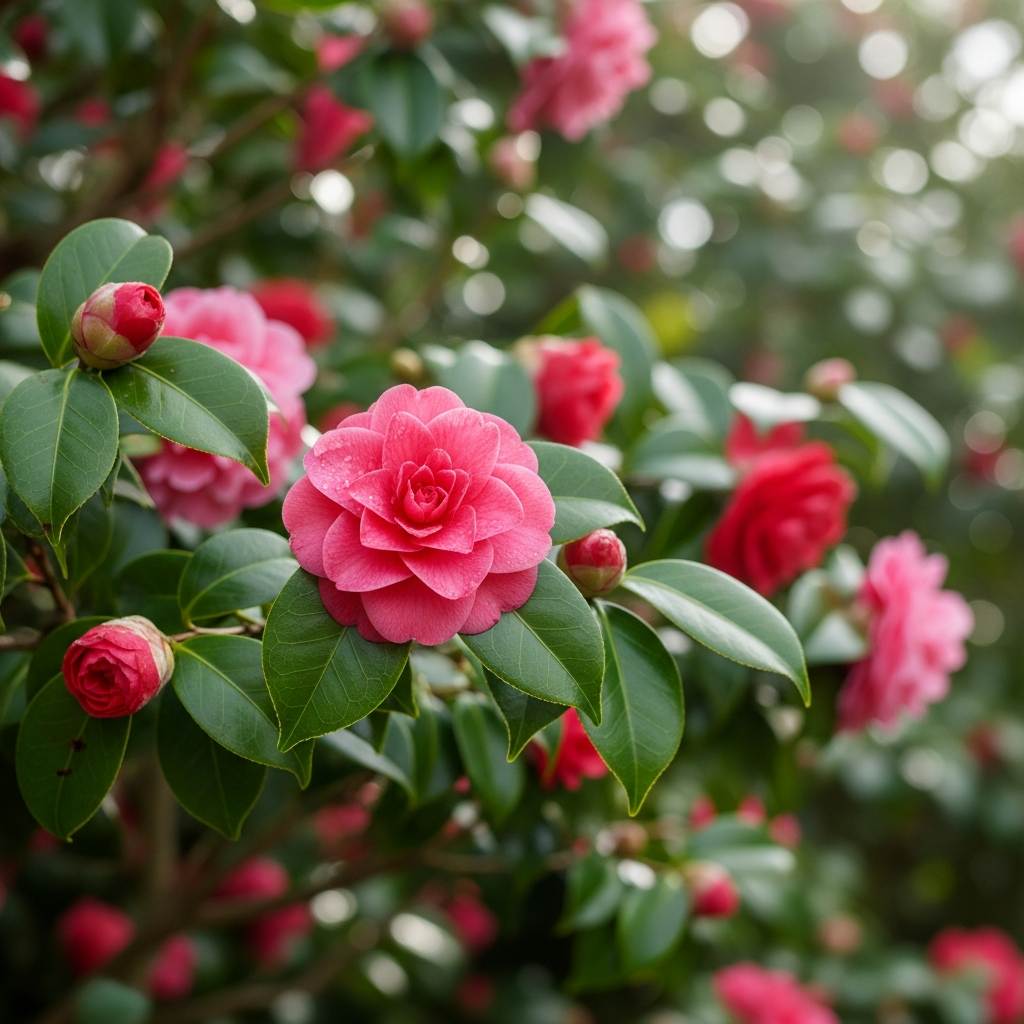
The Good News First: Prevention is Key
The best news about camellia pests is that healthy, well-cared-for plants are remarkably resistant to problems. Most pests and diseases attack stressed or neglected plants, so providing proper care—good soil, adequate water, appropriate light, and proper nutrition—is your first line of defense. Think of it as keeping your plants strong enough to fight off the bad guys naturally.
Regular monitoring is actually a pleasant interlude in the garden—wandering from one camellia to another and checking on your plants. Early detection makes all the difference. Catch problems early, and they’re much easier to manage. Catch them late, and you might be in for a battle.
The Most Aggressive Gang Member: tea scale
Meet Tea Scale: The Al Capone of Camellia Pests
Tea scale is the most aggressive gang member you’ll encounter. It’s the Bugsy Moran of the Insect Gang—persistent, damaging, and difficult to control once established. Tea scale typically begins to invade territory a few years after plants are established, often when plants are stressed or conditions aren’t optimal.
What to Look For:
- Yellow blotches on upper leaf surfaces—the first sign something’s wrong
- Tiny, tough brown females on the underside of leaves
- Webby-looking males covered with waxy white scales
- Rough brown dots that you can feel when you run your fingers over leaves
- Cottony or webby appearance on leaf undersides from male scales
The Life Cycle (The Love Life of Tea Scale):
The females do the eating, the males do the mating. Those rough brown dots you see and feel are females with armored scales—immovable, voracious. They protect their eggs under that armor. When the eggs hatch, the young move about seeking a new home. First hatching is usually in spring when weather gets warm, but there can be several hatchings in a season.
Once a female pierces a leaf and begins to suck its juices, she’s anchored in place. They’re the culprits that create the yellow blotches. The males, with no mouthparts, spend their days chasing pheromones to find mates. The males are covered with waxy white scales and give the leaf a webby or cottony look. Often, they can be rubbed off a leaf.
Why This Matters:
The best time to get the female is after she has hatched and is still moving about to find a permanent home. Once she’s armored in place, she’s more difficult to eradicate. Timing your control measures is crucial.
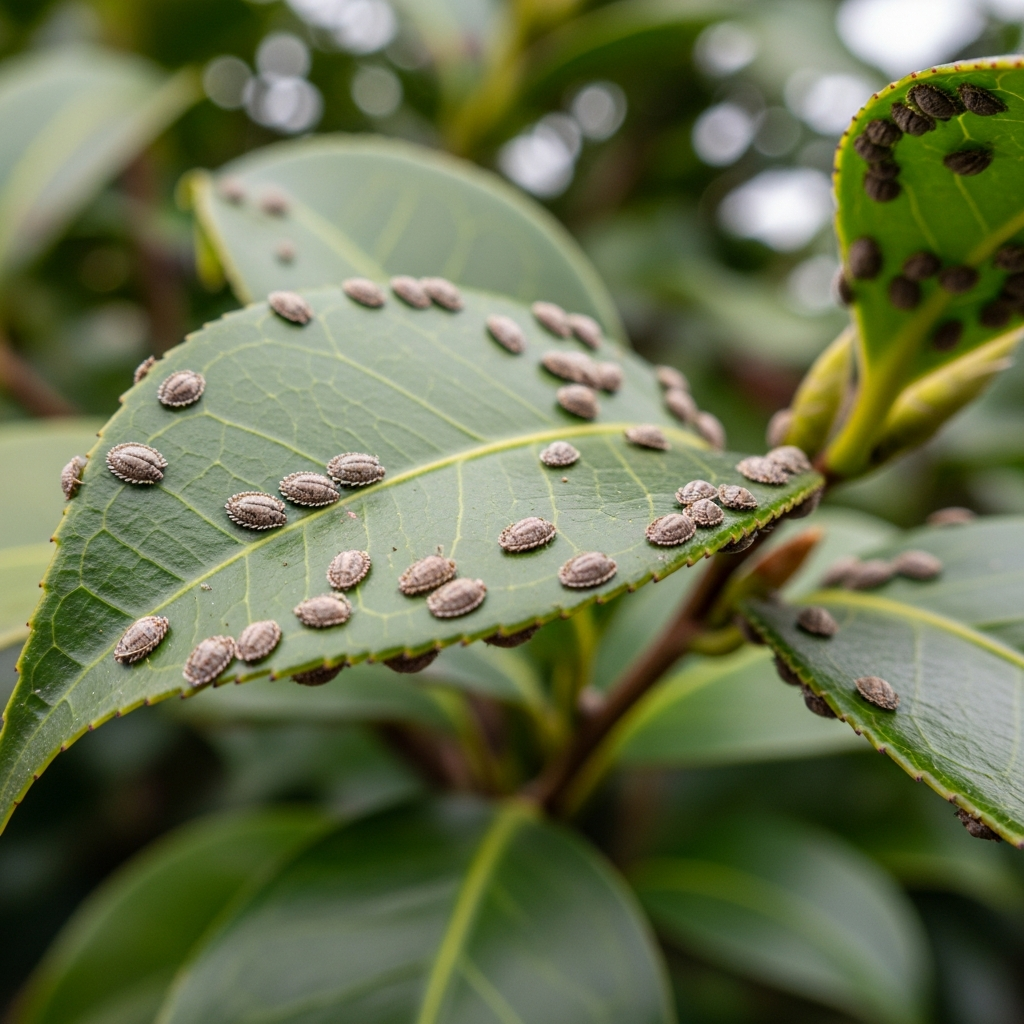
Control Methods:
- horticultural oils: Apply during the growing season when crawlers are active
- Systemic insecticides: Can be effective but use carefully
- Regular monitoring: Check leaf undersides regularly for early detection
- Prune heavily infested branches: Remove severely affected areas
- Biological controls: Encourage beneficial insects that prey on scale
Prevention Tips:
- Maintain plant health through proper care
- Ensure good air circulation around plants
- Avoid over-fertilization that creates tender growth
- Monitor regularly, especially during spring and summer
- Treat early before populations build up
Other Common Camellia Pests
spider mites: The Tiny Web Weavers
Spider mites are tiny arachnids (not insects!) that can cause significant damage, especially during hot, dry weather. They’re so small you might not see them, but you’ll see their damage.
What to Look For:
- Fine webbing on leaves and stems
- Yellow stippling on leaf surfaces (tiny yellow dots)
- Leaves appearing dusty or dirty
- Leaves turning bronze or brown and dropping
- Visible mites (tiny moving dots) when you shake a leaf over white paper
When They Strike:
Spider mites love hot, dry conditions. They’re most active during hot, dry weather, especially in late summer. Plants stressed by drought are particularly vulnerable.
Control Methods:
- Horticultural oils: Very effective against spider mites
- Insecticidal soaps: Can help control populations
- Increase humidity: Mist plants during dry weather
- Water regularly: Keep plants well-hydrated
- Biological controls: Predatory mites can help control populations
Prevention:
- Monitor during hot, dry weather
- Keep plants well-watered during dry spells
- Increase humidity around plants if possible
- Check plants regularly for early signs
Aphids: The Sap-Sucking Squad
Aphids are small, soft-bodied insects that cluster on new growth, sucking plant sap and potentially spreading diseases. They’re common but usually less serious than scale.
What to Look For:
- Clusters of small insects on new growth and buds
- Sticky residue (honeydew) on leaves
- Sooty mold (black fungus) growing on honeydew
- Curled or distorted leaves
- Ants tending to aphids (they’re after the honeydew)
Control Methods:
- Horticultural oils: Effective against aphids
- Insecticidal soaps: Can help control populations
- Strong water spray: Can knock aphids off plants
- Biological controls: Ladybugs and lacewings love aphids
- Neem oil: Can help control populations
Prevention:
- Monitor new growth regularly
- Encourage beneficial insects
- Avoid over-fertilization that creates tender growth
- Keep plants healthy and vigorous
Thrips: The Sneaky Flower Thieves
Thrips are tiny insects that can damage flowers and buds, causing them to fail to open or appear distorted. They’re particularly frustrating because they attack the blooms you’re waiting for.
What to Look For:
- Flower buds that fail to open or open partially
- Distorted flowers with brown streaks or spots
- Silvery or bronze streaks on leaves
- Tiny moving insects on flowers or buds
- Premature flower drop
Control Methods:
- Horticultural oils: Apply during bud development
- Systemic insecticides: Can be effective but timing is critical
- Remove damaged flowers: Remove and destroy affected blooms
- Biological controls: Some beneficial insects prey on thrips
Prevention:
- Monitor buds during development
- Remove damaged flowers promptly
- Maintain good air circulation
- Keep plants healthy to reduce susceptibility
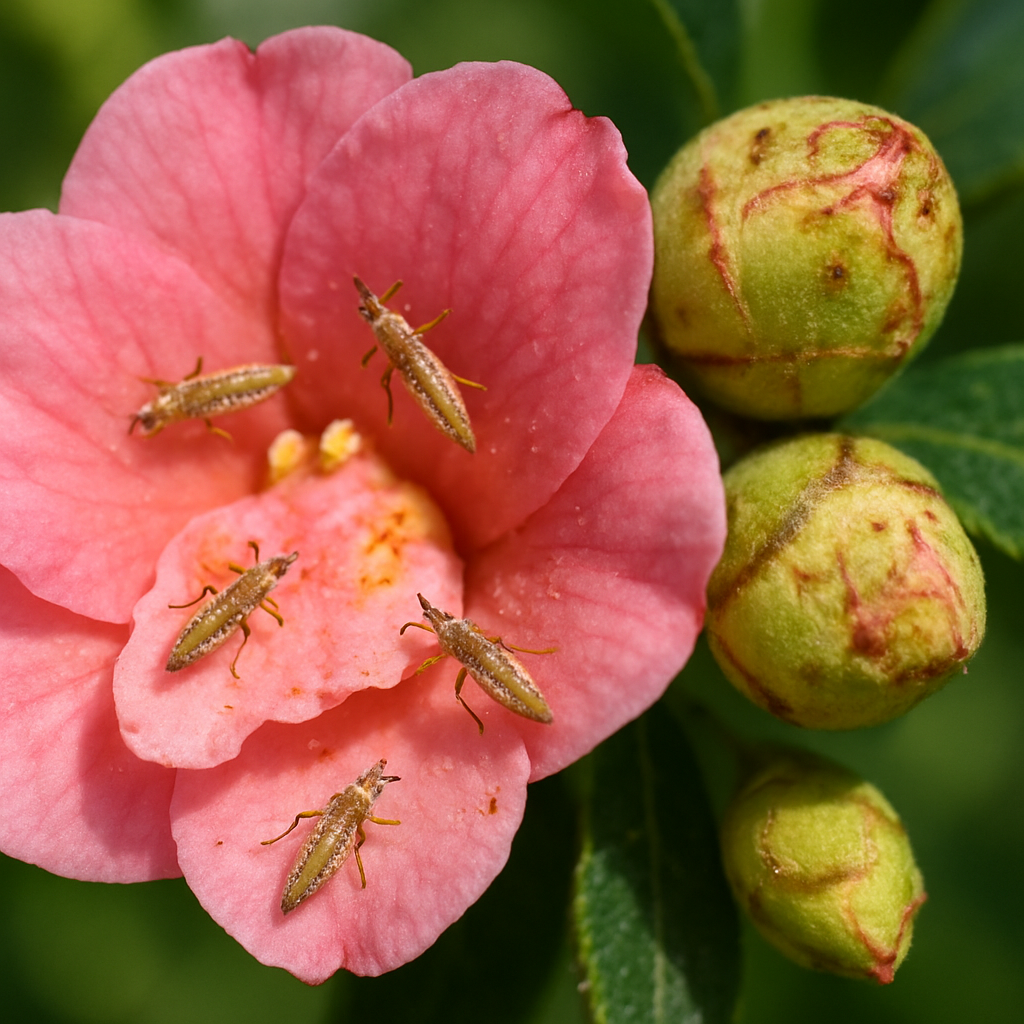
Mealybugs: The Cottony Coating Crew
Mealybugs are soft-bodied insects covered with a white, waxy, cottony coating. They cluster in protected areas like leaf axils and under leaves.
What to Look For:
- White, cottony masses on leaves and stems
- Sticky residue (honeydew) on leaves
- Sooty mold growing on honeydew
- Yellowing or stunted growth
- Clusters in protected areas like leaf axils
Control Methods:
- Horticultural oils: Very effective against mealybugs
- Insecticidal soaps: Can help control populations
- Alcohol swabs: Can remove small infestations
- Biological controls: Some beneficial insects prey on mealybugs
Prevention:
- Monitor regularly, especially in protected areas
- Maintain good air circulation
- Keep plants healthy and vigorous
- Inspect new plants before adding to garden
Scale Insects: The Armored Army
Beyond tea scale, other scale insects can attack camellias. These armored pests are similar to tea scale but may have different appearances and life cycles.
What to Look For:
- Small, immobile bumps on leaves and stems
- Yellowing leaves or stunted growth
- Sticky residue from some scale types
- Sooty mold on honeydew
- Various colors depending on scale type
Control Methods:
- Horticultural oils: Most effective control method
- Systemic insecticides: Can be effective when crawlers are active
- pruning: Remove heavily infested branches
- Biological controls: Some beneficial insects prey on scale
Prevention:
- Monitor regularly for early detection
- Maintain plant health
- Ensure good air circulation
- Treat early before populations build up
Common Camellia Diseases
Camellia flower blight: The Bloom Destroyer
Camellia flower blight is a fungal disease that attacks flowers specifically, causing them to rot and turn brown. It’s particularly frustrating because it ruins the blooms you’ve been waiting for.
What to Look For:
- Brown spots on petals that spread rapidly
- Flowers turning brown and falling off
- Rotting flowers that become mushy
- Brown fungal growth on affected flowers
- Flowers that fail to open or open partially before rotting
Control Methods:
- Remove all affected flowers immediately and dispose of them (don’t compost!)
- Remove all dead blooms from plant and ground
- Fungicide applications: Can help prevent spread
- Good sanitation: Remove all plant debris from around plants
- Improve air circulation: Prune to allow better air movement
Prevention:
- Remove spent blooms regularly (don’t let them rot on the plant)
- Clean up fallen flowers from around plants
- Avoid overhead watering that wets flowers
- Maintain good air circulation around plants
- Choose resistant varieties when possible
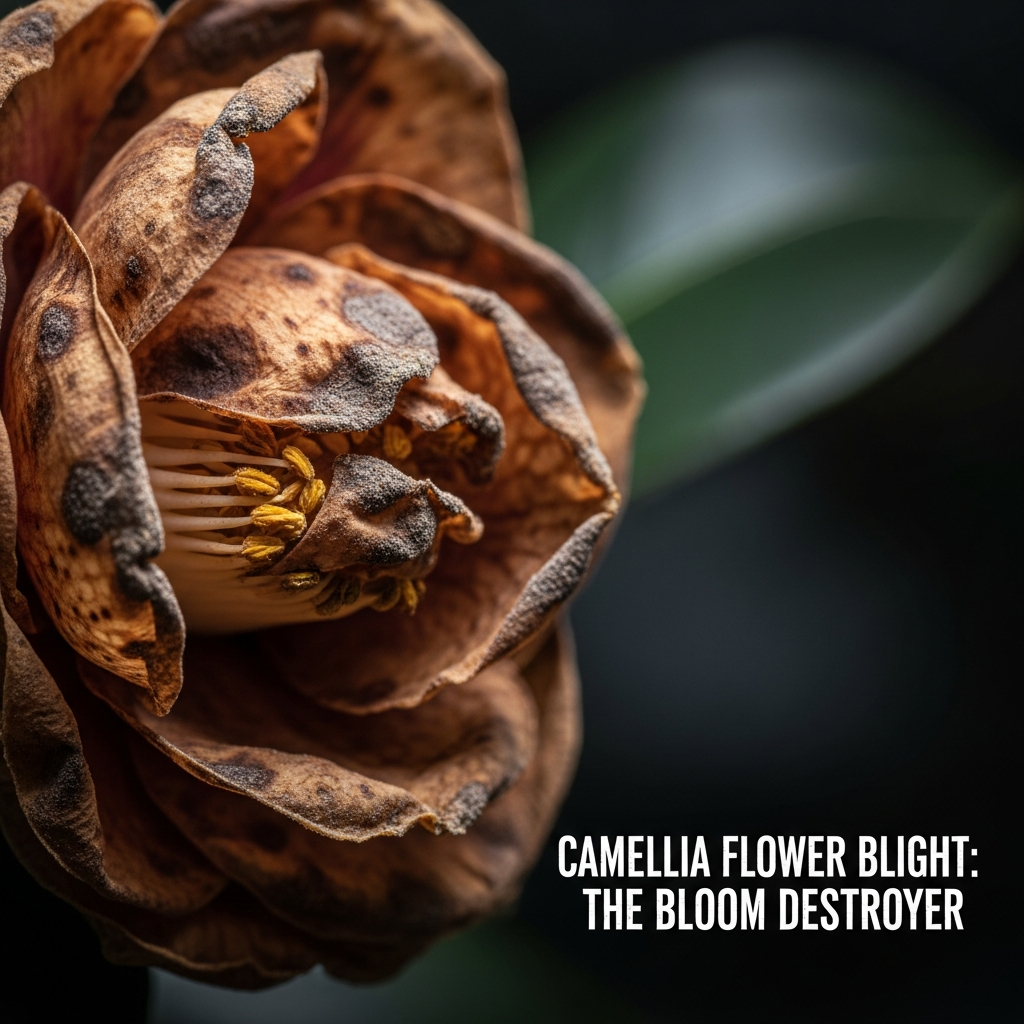
Root Rot: The Silent Killer
Root rot is a serious fungal disease that attacks roots, often killing plants slowly or quickly. It’s usually caused by poor drainage or waterlogged soil.
What to Look For:
- Yellowing leaves that don’t improve with fertilization
- Wilting despite adequate moisture
- Stunted growth or decline
- Roots that are brown and mushy instead of white and firm
- Plant death that seems sudden but was actually gradual
Control Methods:
- Improve drainage: This is critical—add organic matter, create raised beds, or improve drainage
- Remove affected plants: If root rot is advanced, remove plant to prevent spread
- Fungicide treatments: May help if caught very early
- Preventive measures: Ensure good drainage before planting
Prevention:
- Ensure good drainage before planting
- Don’t plant too deep
- Avoid overwatering
- Improve soil structure with organic matter
- Monitor for early signs of stress
Leaf Spot Diseases: The Spotted Menace
Various fungal diseases can cause spots on camellia leaves. While usually not fatal, they can affect plant appearance and health.
What to Look For:
- Brown or black spots on leaves
- Yellow halos around spots
- Leaves dropping prematurely
- Spots that grow and merge
- Fungal growth on affected areas
Control Methods:
- Remove affected leaves: Remove and destroy heavily infected leaves
- Fungicide applications: May help control spread
- Improve air circulation: Prune to allow better air movement
- Avoid overhead watering: Water at base of plant
- Good sanitation: Remove fallen leaves from around plants
Prevention:
- Maintain good air circulation
- Avoid overhead watering
- Keep leaves dry when possible
- Remove affected leaves promptly
- Choose resistant varieties when possible
Canker Diseases: The Branch Killers
Canker diseases cause areas of dead tissue on branches, often leading to branch dieback or death.
What to Look For:
- Sunken areas on branches
- Dead or dying branches
- Cracks in bark
- Discolored areas on branches
- Branches that die back from tips
Control Methods:
- Prune affected branches: Remove well below the canker
- Disinfect tools: Clean tools between cuts
- Fungicide treatments: May help prevent spread
- Improve plant health: Healthy plants resist disease better
- Remove severely affected plants: Prevent spread to other plants
Prevention:
- Maintain plant health through proper care
- Avoid wounding plants unnecessarily
- Prune properly with clean tools
- Ensure good air circulation
- Monitor for early signs
The Most Effective Control Method: Horticultural Oils
Why Horticultural Oils Work
Horticultural oils are among the most effective and environmentally friendly methods for controlling many camellia pests. They work by smothering pests and their eggs, preventing them from breathing.
How They Work:
- Smother pests: Cover pests with a thin film of oil
- Block breathing: Prevent pests from taking in oxygen
- Kill eggs: Destroy pest eggs before they hatch
- Safe for beneficials: Less harmful to beneficial insects than chemical insecticides
- Low toxicity: Generally safe for humans and pets when used properly
When to Use:
- During growing season: When pests are active
- Early in pest lifecycle: When crawlers are moving about
- Regular applications: May need multiple applications for control
- Follow label directions: Always read and follow product labels
- Timing matters: Apply when pests are vulnerable
Application Tips:
- Apply thoroughly to all surfaces, especially undersides of leaves
- Ensure good coverage for effective control
- Apply when temperatures are moderate (not too hot or cold)
- Don’t apply when plants are stressed
- Monitor for effectiveness and reapply as needed
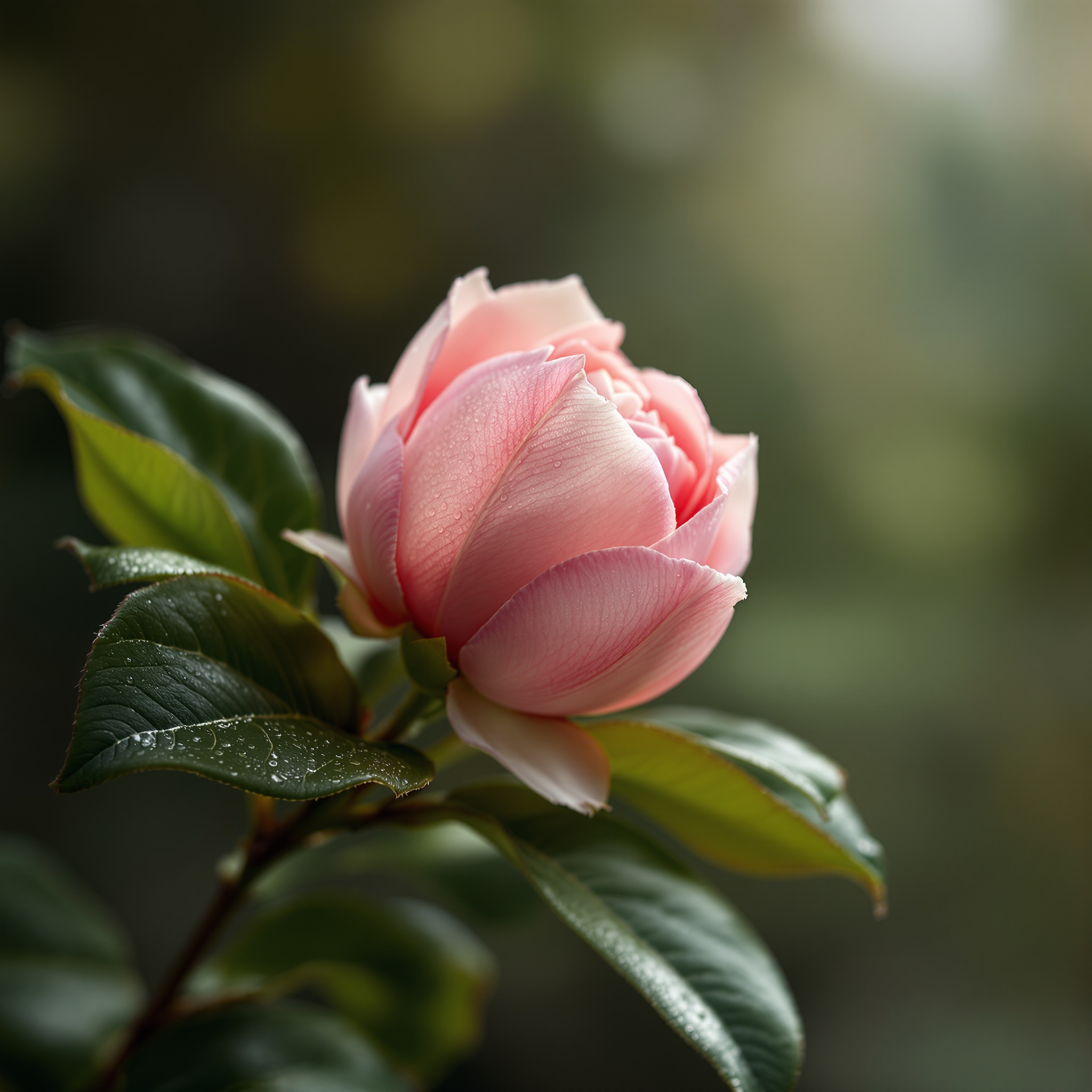
Recommended Products for Camellia Pest and Disease Control
Having the right tools and products on hand makes managing camellia pests and diseases much easier. Here are some highly effective products that can help you keep your camellias healthy and pest-free. These recommendations are based on proven effectiveness and ease of use for home gardeners.
1. Bonide Captain Jack Copper Fungicide
16 oz Concentrated Plant Disease Control Solution for Organic Gardening
When to Use: Use this copper fungicide when you see signs of camellia flower blight, leaf spot diseases, or other fungal problems. It’s approved for organic gardening and can be used up to the day of harvest. Apply when you notice brown spots on flowers, black spots on leaves, or signs of powdery mildew. Copper fungicide works by creating a protective barrier on plant surfaces that prevents fungal spores from germinating. Apply every 7-10 days as a preventive measure during humid weather, or immediately when you see disease symptoms. Mix with water according to package directions and thoroughly apply to affected plants, covering both tops and undersides of leaves.
Best For: Fungal diseases like flower blight, leaf spot, powdery mildew, and black spot. I’ve found this copper fungicide particularly effective when applied early in the season as a preventive measure. In my experience, once flower blight shows up, it can spread quickly through a camellia bed, but this product has stopped it in its tracks when applied at the first sign of brown spots on petals. The organic approval means I can use it without worrying about harming beneficial insects or the environment. It’s especially valuable during humid spring weather when fungal diseases are most likely to appear.
2. Horticultural Oil Spray
Ready-to-use horticultural oil for organic pest control
When to Use: Use horticultural oil when you see tea scale, spider mites, aphids, or mealybugs on your camellias. This is one of the most effective and environmentally friendly pest control methods. Apply during the growing season when pests are active, especially in early spring when crawlers are moving about. Horticultural oil works by smothering pests and their eggs. Apply thoroughly to all surfaces, especially the undersides of leaves where pests hide. Use when temperatures are moderate (between 40-90°F) and avoid applying during very hot or very cold weather. Reapply every 7-14 days as needed until pests are under control. This ready-to-use formula makes application easy—no mixing required.
Best For: Tea scale, spider mites, aphids, mealybugs, and other soft-bodied pests. This has become my go-to solution for tea scale problems. After struggling with tea scale for a season, I started using horticultural oil in early spring when the crawlers are active, and it made a huge difference. The key is thorough application—I make sure to get the undersides of every leaf where the pests hide. I’ve also found it works wonders on spider mite infestations that appear during hot, dry weather. The ready-to-use formula saves time, and I’ve noticed the plants bounce back quickly after treatment. It’s gentle enough that I can use it regularly without worrying about plant stress.
3. Systemic Insecticide for Ornamentals
Systemic insecticide concentrate for long-lasting pest control
When to Use: Use systemic insecticide when you have persistent pest problems that don’t respond to horticultural oils or other surface treatments. This is particularly effective for tea scale and other scale insects that are heavily armored. Apply in early spring when plants are actively growing, as the plant needs to absorb the insecticide through its roots. Systemic insecticides work from the inside out—the plant absorbs the chemical and it circulates through the plant tissue, making all parts toxic to pests that feed on it. This is especially useful for large infestations or when you need long-lasting protection. Follow label directions carefully and avoid using during bloom time if you want to protect pollinators. Mix with water and apply to soil around the base of the plant.
Best For: Heavy scale infestations, persistent pest problems, or when you need long-lasting protection. I’ve used this when tea scale has gotten out of hand and horticultural oils weren’t enough. It’s particularly effective for established scale infestations where the pests are heavily armored and difficult to reach with surface treatments. In my experience, applying this in early spring gives the plant all season protection, which is invaluable when dealing with recurring pest problems. It’s saved several of my camellias that were on the verge of being lost to severe scale infestations. However, I’m careful to only use it when really needed, as it’s more powerful than the oil-based treatments.
Recommended Products for Camellia Pest and Disease Control
Having the right tools and products on hand makes managing camellia pests and diseases much easier. Here are some highly effective products that can help you keep your camellias healthy and pest-free. These recommendations are based on proven effectiveness and ease of use for home gardeners.
1. Bonide Captain Jack Copper Fungicide
16 oz Concentrated Plant Disease Control Solution for Organic Gardening
When to Use: Use this copper fungicide when you see signs of camellia flower blight, leaf spot diseases, or other fungal problems. It’s approved for organic gardening and can be used up to the day of harvest. Apply when you notice brown spots on flowers, black spots on leaves, or signs of powdery mildew. Copper fungicide works by creating a protective barrier on plant surfaces that prevents fungal spores from germinating. Apply every 7-10 days as a preventive measure during humid weather, or immediately when you see disease symptoms.
Best For: Fungal diseases like flower blight, leaf spot, powdery mildew, and black spot
2. Horticultural Oil
Neem oil or horticultural oil spray for pest control
When to Use: Use horticultural oil when you see tea scale, spider mites, aphids, or mealybugs on your camellias. This is one of the most effective and environmentally friendly pest control methods. Apply during the growing season when pests are active, especially in early spring when crawlers are moving about. Horticultural oil works by smothering pests and their eggs. Apply thoroughly to all surfaces, especially the undersides of leaves where pests hide. Use when temperatures are moderate (between 40-90°F) and avoid applying during very hot or very cold weather. Reapply every 7-14 days as needed until pests are under control.
Best For: Tea scale, spider mites, aphids, mealybugs, and other soft-bodied pests
3. Systemic Insecticide
Systemic insecticide for long-lasting pest control
When to Use: Use systemic insecticide when you have persistent pest problems that don’t respond to horticultural oils or other surface treatments. This is particularly effective for tea scale and other scale insects that are heavily armored. Apply in early spring when plants are actively growing, as the plant needs to absorb the insecticide through its roots. Systemic insecticides work from the inside out—the plant absorbs the chemical and it circulates through the plant tissue, making all parts toxic to pests that feed on it. This is especially useful for large infestations or when you need long-lasting protection. Follow label directions carefully and avoid using during bloom time if you want to protect pollinators.
Best For: Heavy scale infestations, persistent pest problems, or when you need long-lasting protection

1 thought on “Insects and Critters to Watch Out For on Camellias: A Gardener’s Guide to Pest Management”